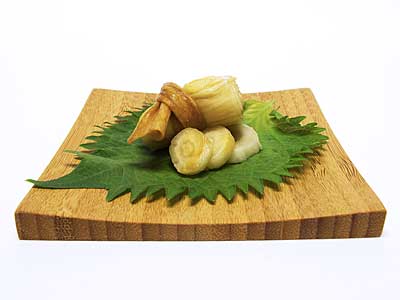August 6, 2012
Amuse-Bouche

endive au « miso »
(miso-cured endive)
Endive—often referred to as Belgian endive to differentiate it from other vegetables called endive—is really a nothing vegetable! It has name problems: both as to what is the proper name and how to properly pronounce it. It doesn’t occur in nature and cannot be sold as a natural product. It is neither widely produced nor widely available. While it can be very crisp when raw, it becomes sickly limp when cooked a little bit too much. Its bitter taste is only attractive to like-minded adults. It has to be grown in the dark and stored in the same manner. It’s sensitive to rough handling. It’s expensive. And for those who live outside our area, not locally grown.
With all this going against it, why would I drive two hours to visit the largest endive grower in the United States? As I was fighting traffic, I was wondering the same thing. I eventually wound up at California Vegetable Specialties in Rio Vista, CA. The visit consisted of an introductory lecture⁄video, a tour of the forcing room where the saleable endive are grown, and a lunch made from a few endive inspired recipes. The group consisted mainly of food writers, a few chefs, and two culinary instructors. When we finished, each one of us received a bag of promotional materials and a package of three endives.
Although I did have a new respect for the lowly endive when I left, nothing had changed in the outside world except I now could become an ally in the marketing campaign to educate people about endive, an assignment I chose to decline. But that didn’t mean I’d let my three specimens go to waste. The red one was cut crosswise into 1-cm (3⁄8-in) pieces and added to the night’s salad. The other two had something more devious waiting for them: a 3-month long bath in shiro (white) miso.
On my next trip to an Asian market I purchased a large tub of the least expensive miso I could find. After all, I didn’t know if I would like the end product, and I had already spent the time and money to drive 280 km (175 mi) and paid a few bridge tolls. I transferred the miso to a large deli container and pushed the two heads of endive into the miso so they were fully submerged and not in contact with each other or the sides of the container. After marking the contents and date on the lid, the container was closed and placed in the rear of my refrigerator.
After about 8 weeks, I pulled one of the heads from its bed. There was a lot of water around the head, and it had shrunk significantly. Most of the color was now gone, and the overall appearance was slightly sickly. I cut a piece from the tip and tasted it. Hmmm. Quite nice. It was ready to eat, but there wasn’t a suitable occasion yet. So back into the miso it went.
After about 12 weeks, a dinner was scheduled where I could now serve the endive as an amuse-bouche. Now I had to decide how I wanted to serve it. I knew that I wanted to cut the endive into bite-sized lengths, and that I would need something to hold them together. I liked the idea of using a chive to tie them in shape, but I’ve had problems with chives breaking when used for such a purpose. Then I thought of kanpyo, a dried gourd strip used in Japanese cooking as an edible tie. I soaked a strip of the kanpyo in equal portions of dark soy sauce, rice vinegar, and water for an hour or so. Since the color was pretty much gone from the endive, and the kanpyo was only slightly more colorful, I decided to serve the combination on a shiso leaf.
After I removed the two heads of endive from the miso and rinsed them off, I noticed that the core of the endive was now much more pronounced than when the vegetable was fresh. It was like comparing a normal person to one close to starvation who was now mostly skin and bones. So after cutting the pieces to serving length, I felt for the core and removed it by making a slit carefully along the length each piece. This allowed me to “unwrap” the leaves from around the core. Once the core was separated, I carefully reformed the leaves into a cylinder that I tied with a piece of the kanpyo. The core was cut into slices to be served along with the leaves. After trimming the ends of the kanpyo ties, the servings were assembled.
As with the other miso-cured items, oysters and scallops, already presented on this blog, the cured endive does not taste salty. With the endive there was also a strong hint of the miso that wasn’t present with the shellfish. The miso flavor combined very nicely with the fresh sauerkraut-like flavor produced by the lactic acid fermentation brought about by the salt in the miso. It produced a very nice couple of bites.
© 2012 Peter Hertzmann. All rights reserved.
